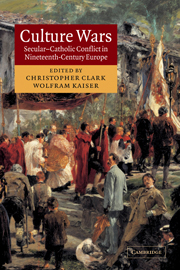Book contents
- Frontmatter
- Contents
- List of illustrations
- List of contributors
- Introduction: The European culture wars
- 1 The New Catholicism and the European culture wars
- 2 ‘Clericalism – that is our enemy!’: European anticlericalism and the culture wars
- 3 ‘Priest hits girl’: on the front line in the ‘war of the two Frances’
- 4 The battle for monasteries, cemeteries and schools: Belgium
- 5 Contested rituals and the battle for public space: the Netherlands
- 6 Nonconformity, clericalism and ‘Englishness’: the United Kingdom
- 7 The assault on the city of the Levites: Spain
- 8 Roma o morte: culture wars in Italy
- 9 Enemies at the gate: the Moabit Klostersturm and the Kulturkampf: Germany
- 10 Village quarrels and national controversies: Switzerland
- 11 The Counter-Reformation's last stand: Austria
- 12 The uncivil origins of civil marriage: Hungary
- Annotated bibliography
- Index
5 - Contested rituals and the battle for public space: the Netherlands
Published online by Cambridge University Press: 23 July 2009
- Frontmatter
- Contents
- List of illustrations
- List of contributors
- Introduction: The European culture wars
- 1 The New Catholicism and the European culture wars
- 2 ‘Clericalism – that is our enemy!’: European anticlericalism and the culture wars
- 3 ‘Priest hits girl’: on the front line in the ‘war of the two Frances’
- 4 The battle for monasteries, cemeteries and schools: Belgium
- 5 Contested rituals and the battle for public space: the Netherlands
- 6 Nonconformity, clericalism and ‘Englishness’: the United Kingdom
- 7 The assault on the city of the Levites: Spain
- 8 Roma o morte: culture wars in Italy
- 9 Enemies at the gate: the Moabit Klostersturm and the Kulturkampf: Germany
- 10 Village quarrels and national controversies: Switzerland
- 11 The Counter-Reformation's last stand: Austria
- 12 The uncivil origins of civil marriage: Hungary
- Annotated bibliography
- Index
Summary
INTRODUCTION
‘Zurück!’ (Stand back!) shouted Pastor Quaedvlieg, a priest from the Prussian border town of Haaren, when he and the members of his procession were brought to a halt by three Dutch national policemen in the autumn of 1878. Only shortly before, he and his pilgrims, returning from the important Marian shrine of Our Lady in 't Zand near Roermond in the southern Dutch province of Limburg, had formed a liturgical procession. Quaedvlieg had donned his chasuble in a field, brought out the processional cross and unfurled the liturgical processional banners. Then he had directed the forming of ranks: first two columns of women, then himself in the middle, then two columns of men, and finally the train, consisting of three covered wagons with baggage. In doing this he was deliberately taking a risk; since the beginning of the Kulturkampf in Prussia, the rules relating to public religious rituals had also been sharpened in Dutch Limburg, and throughout the Netherlands the holding of religious rituals in public had become an extremely sensitive issue. Of the eleven provinces of the Kingdom of the Netherlands, only the two most southern, North Brabant and Limburg, had Catholic majorities. Of the 230,000 inhabitants of Limburg, about 99 per cent were Catholic. From 1830 to 1839 Limburg had belonged to the newly formed Belgium, and until the 1860s it was part of both the Netherlands and the German Bund.
- Type
- Chapter
- Information
- Culture WarsSecular-Catholic Conflict in Nineteenth-Century Europe, pp. 129 - 151Publisher: Cambridge University PressPrint publication year: 2003
- 5
- Cited by



